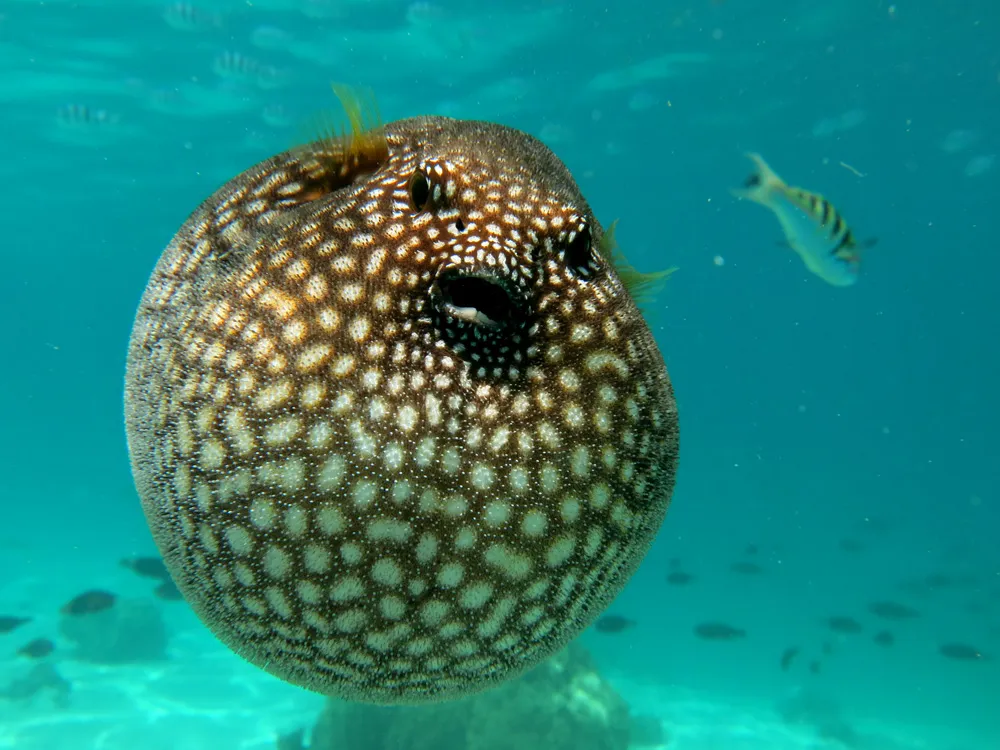The Fascinating World of Puffer Fish

Puffer fish, also known as blowfish, are one of the most intriguing and easily recognizable marine creatures. With their unique ability to inflate themselves into spiky, balloon-like forms, these fish have captivated both marine biologists and casual ocean enthusiasts. Puffer Fish Found mainly in warm and temperate waters, belong to the family Tetraodontidae, which includes nearly 200 different species. Despite their delicate appearance, are hardy survivors in the underwater world.

Physical Characteristics of Puffer Fish
vary greatly in size, from a few inches to over two feet long, depending on the species. Their rounded bodies and bulging eyes contribute to their distinctive look. One of their most remarkable features is their highly elastic stomachs, which they fill with water (or sometimes air) when threatened, making them appear up to three times their normal size. This expansion serves as a defense mechanism, deterring predators who might not find a giant, spiky sphere an appealing meal.
Some species of have sharp spines that add an extra layer of protection when they puff up. Coupled with their defensive capabilities is a remarkable color range, allowing them to camouflage against coral reefs, sea grasses, and rocky ocean floors.
Species Diversity and Distribution
The Tetraodontidae family includes a broad array of species, each with unique adaptations suited to their specific environments. The tiny dwarf arinotetraodon travancoricus) lives primarily in freshwater habitats, while the larger and more striking species like the giant puffer (Arothron stellatus) thrive in deeper oceanic waters. re mainly distributed in tropical and subtropical regions, with a notable presence in the Indo-Pacific, Atlantic, and Mediterranean Sea.

The Puffing Mechanism Explained
A hallmark of the h is its ability to puff up when threatened. This act is not just a simple inflation but an intricate biological process involving rapid intake of water into their elastic stomachs. The quick expansion makes them appear much larger and more difficult to swallow, which can dissuade potential predators. Unlike other fish have no scales but are covered with a rough, sometimes spiny skin that becomes rigid when puffed.
The puffing action is taxing on their energy reserves and is only used when absolutely necessary. After deflating, may need hours to recover and realign their body systems back to normal functioning.
Poisonous Yet Popular: The Toxins of Puffer Fish
One of the most fascinating—and dangerous—aspects of is their production of tetrodotoxin, a potent neurotoxin that is deadly to many predators, including humans. This toxin is primarily found in the liver, ovaries, intestines, and skin. Interestingly, tetrodotoxin is up to 1,200 times more toxic than cyanide. A single contains enough poison to kill several humans, yet it leaves most natural predators unharmed due to their evolved resistance.
Despite these dangers, the has carved out a niche in human culture, most notably in Japanese cuisine as fugu. Expert chefs are trained for years to prepare this delicacy safely, removing toxic parts with precision to avoid contamination.

The Role of Puffer Fish in Various Cultures
In Japan, the preparation and consumption of fugu is not just a meal but an art form. Only certified chefs can legally serve fugu, and stringent regulations are in place to prevent accidental poisoning. The appeal lies in the subtle flavors of the fish, complemented by the thrill of knowing that improper preparation can be lethal.
have also played roles in folklore and art across various cultures. Some societies view them as symbols of bravery due to their ability to face predators head-on, while others see them as emblems of duality—beauty laced with danger.
The Art and Science of Preparing Fugu
The preparation of fugu is a meticulous process that requires years of training. Chefs must learn to identify the toxic organs and safely separate them from the edible portions. It is said that the real mastery lies in preparing the fish so expertly that only a subtle, safe trace of toxin remains, creating a tingling sensation on the tongue that fugu enthusiasts crave.
The culinary use of strictly regulated in Japan, with restaurants requiring special licenses. The handling and serving procedures ensure diners experience the unique taste while minimizing health risks.
Puffer Fish in the Aquarium Trade
Many marine hobbyists are fascinated by h, making them popular in the aquarium trade. Species like the Tetraodon nigroviridis (green spotted puffer) are particularly sought after due to their distinctive appearance and engaging personalities. However, caring for a p requires specific conditions, such as adequate tank space, a varied diet including hard-shelled food to help wear down their continuously growing teeth, and a stable aquatic environment.
The Diet and Feeding Behavior of Puffer Fish
Puffer fish are omnivorous and have diverse feeding habits. In the wild, they primarily eat algae, mollusks, crustaceans, and small invertebrates. Their strong, beak-like teeth allow them to crack open shells and consume prey that would be inaccessible to many other fish. Observing a hunt can be mesmerizing as they use their quick movements and sharp eyesight to secure meals.
Reproduction and Life Cycle
Reproduction in puffer fish varies by species but generally involves intricate mating rituals. Typically, males prepare a “nest” in sandy or rocky seafloors where the female can lay her eggs. After fertilization, the male may guard the eggs until they hatch. The larvae are planktonic initially, drifting in the ocean currents before growing and settling into their habitats.
Conservation Status and Threats
Though puffer fish are resilient, they face threats from overfishing, habitat loss, and climate change. Some species have been affected more significantly than others, prompting conservation measures in certain regions. Their role in marine ecosystems as both predator and prey makes their presence crucial for maintaining balance within their environments.
Fascinating Facts About Puffer Fish
- an inflate up to three times their size without bursting, thanks to their highly elastic skin.
- Not all are poisonous, though most contain some levels of tetrodotoxin.
- teeth never stop growing, which is why they need a diet that helps wear them down.
The Influence of Puffer Fish in Art and Media
have appeared in various art forms, ranging from traditional Japanese prints to modern animations and movies. Characters based on these unique creatures often embody themes of surprise, resilience, and unexpected strength.
Myths and Misconceptions
One common misconception is that puffer fish can choose when to use their toxin. In reality, their toxicity is a passive defense that deters predation without their direct control. Additionally, while the toxin is lethal, some species are entirely non-toxic or only mildly so.
Tips for Observing Puffer Fish in the Wild
For divers interested in observing h in their natural habitats, patience and respect for their space are key. These fish are generally docile but can puff up if provoked. Maintain a safe distance, avoid sudden movements, and never attempt to handle them.
How Puffer Fish Contribute to Marine Ecosystems
r fish contribute to their ecosystems by controlling populations of smaller marine life such as crustaceans and algae. Their role as both predator and prey ensures a balanced environment, helping sustain the biodiversity of their habitats.
FAQs About Puffer Fish
1. Are all puff poisonous?
Not all species are equally toxic. While most contain some level of tetrodotoxin, a few are non-toxic or only mildly toxic.
2. How do puffer fish inflate?
inflate by rapidly ingesting water (or air when out of water) into their highly elastic stomachs, allowing them to expand up to three times their size.
3. Is it safe to keep a puffer fish as a pet?
Yes, but they require specific care and a suitable environment. They need ample space, a proper diet, and clean, stable water conditions.
4. Can puffer fish bite?
Yes, puffer fish have strong, beak-like teeth capable of biting. They use these teeth mainly for feeding on hard-shelled prey.
5. Why do some puffer fish have spikes?
Spikes are an added defense mechanism. When a spiked inflates, the spikes stand erect, deterring predators from attempting to eat them.
6. What happens if a predator eats a puffer fish?
The tetrodotoxin in s potent enough to kill most predators, including humans, who consume them without proper preparation.

